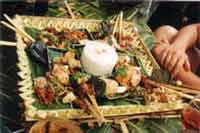|
Theme
Dinner & Lunch
Cocktails, Dinner, Handicrafts and Cultural
Performance In Museum 
The Museum is a centre for visual and performing arts. It
has a permanent exhibition of paintings as well as special
temporary exhibitions, hosts cultural workshops, conferences,
seminars and training programs, music and painting classes
and performances of theatre and dance, and boasts a bookshop,
a library and a reading room.
The permanent exhibition of paintings by Balinese, Indonesian
and foreign artists includes works from the ARMA Foundation's
collection as well as those on loan from the private collection
of Mr. and Mrs. Agung Rai. ARMA's permanent collection consists
of both traditional and contemporary paintings, and includes:
-
Classical Balinese paintings known as kamasan paintings,
which are painted on tree bark;
- Masterpieces
from the famous "painters' village" Batuan, painted
during the village's heyday of the 1930's and 1940's;
- The
only works on Bali by 19th century Javanese artists Raden
Saleh, Syarif Bustaman, and German painter Walter Spies
who lived in Bali in the 1950s.
- Works
by Balinese masters such as I Gusti Nyoman Lempad, Ida Bagus
Made, Anak Agung Gde Sobrat, and I Gusti Made Deblog.
- Foreign
artists who lived and worked in Bali such as Willem Gerard
Hofker, Rudolf Bonnet, Adrien Jean Le Mayeur de Merpres
and Wilem Dooijewaard.
Temporary
shows by both Indonesian and foreign artists include exhibitions
of paintings, textiles, photography, installations and sculpture.
The great majority of works included in ARMA's temporary exhibitions
are contemporary paintings. The Museum is made up of a series
of buildings which, whilst essentially Balinese insofar as
local materials have been used wherever possible, are nevertheless
somewhat grander and more majestic than the typical Balinese
home. The two main buildings, the bale daja (3300 square meters
in area) and the bale dauh (1200 square meters) overlook the
Museum's expansive gardens, which are punctuated here and
there by ponds and fountains, and the whole complex is surrounded
by rice paddies. There is an outdoor performance area, known
as the Open Stage, which not only functions as a venue for
the theatre performances - both Balinese and otherwise - that
the Museum hosts, but also hosts outdoor banquets.
Maximum capacity : 100 persons.
Lunch With Villager Party

 Guests
depart their hotel at approximately 08.30 am, and arrive in
the village at approximately 10.00 am. Participants will be
welcomed by a traditional Balinese Bleganjur orchestra played
by 20 or 25 musicians. Local villagers accompany the participants
along the tour walking through the tropical fruits plantation.
After the walk a welcome cocktail will be served, and then
participants will watch local people demonstrate a range of
daily Balinese activities such as rice processing in the traditional
manner, making offerings and preparing Balinese food and cakes.
Participants may join in the activities, or simply sample
the fare while chatting to the local people. A local cocktail
will also be served. Guests are then served a Balinese meal
in the traditional 'megibung' style, which involves eating
with one's fingers from a communal plate for four people,
which is meant as a symbol of equality. The meal consists
of soup or salad, Balinese food, mixed fruit, coffee or tea.
After lunch participants will observe other activities such
as a cockfight. The final component of the program is the
performance of a Balinese dance. Guests
depart their hotel at approximately 08.30 am, and arrive in
the village at approximately 10.00 am. Participants will be
welcomed by a traditional Balinese Bleganjur orchestra played
by 20 or 25 musicians. Local villagers accompany the participants
along the tour walking through the tropical fruits plantation.
After the walk a welcome cocktail will be served, and then
participants will watch local people demonstrate a range of
daily Balinese activities such as rice processing in the traditional
manner, making offerings and preparing Balinese food and cakes.
Participants may join in the activities, or simply sample
the fare while chatting to the local people. A local cocktail
will also be served. Guests are then served a Balinese meal
in the traditional 'megibung' style, which involves eating
with one's fingers from a communal plate for four people,
which is meant as a symbol of equality. The meal consists
of soup or salad, Balinese food, mixed fruit, coffee or tea.
After lunch participants will observe other activities such
as a cockfight. The final component of the program is the
performance of a Balinese dance.
Maximum capacity : 300 person
|



